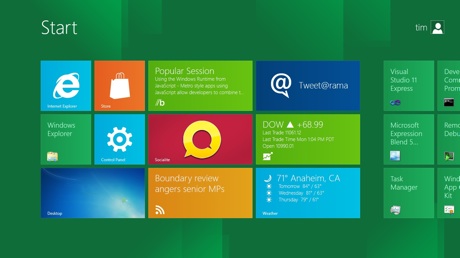
There are two ways make a product successful: either you saturate consumers with marketing so there literally is no other choice but to buy it (“push”), or you make the product so appealing that it hardly needs any marketing capital at all (“pull”).
Apple
Right now, Apple is proving that pull is the approach to take. While I’m a big fan of Android and my only Apple device is a 3rd Generation iPod from 2007 I have to be realistic here and acknowlege the sheer class and artistry that the Cupertino-based company sinks into each new device.
The iPhone really was the start of a global revolution in touch-screen, internet-enabled, pocket-sized devices and I was dubious when the iPad was launched during a recession at twice the price of its nearest competitors, but I was wrong to doubt the undeniable power of the pull effect.
Google+ vs. Facebook
At the same time, I believe Google+ hasn’t been successful because it has been rammed down our throats at every turn. Want a YouTube account so you can comment on a video? You’ll need to sign up to Google+. Want to create a new email account on GMail? Guess what? You’ll need a G+ account… Humans are naturally averse to being forced into something; the aversion is considerably greater when technology is involved and exponentially greater when the service being forced onto us asks for our personal details. Now, Google has shot itself in the foot, Google+ is actually a VERY, VERY GOOD service, Hangouts are incredible and the whole common Google estate idea will make it easier for users to live their lives. But Google shouldn’t have been so arrogant as to tell us what we should be doing.
I strongly believe that the feeling of being “left out” of something is a greater driver to making people take action than being told to take action. The entire Apple reinvention over the past decade has gone from strength to strength on this ethos. Google+ had nothing but great publicity when it was in its early “invitation-only” stage and the not-obligatory launch and acceleration phases after that. It was when Google’s centralised Privacy Policy came about, and then Google+ accounts became mandatory to use completely unrelated parts of Google’s online empire that the really bad stuff started to come out.
Facebook has used the Pull effect since day one too: “my friends are all on Facebook, they’re sharing, they’re talking, I’M BEING LEFT OUT!!!”. And despite their stock price diving with more ability than Tom Daley, nobody is thinking less of the actual service offered.
Windows 8
So Microsoft started the week by applauding themselves as Windows 8 went “RTM” – or Release to Manufacture. The big feature of Windows 8 (for the consumer) is the new Start Menu:
In all of the demos and previews of Windows 8, thie Start Menu has been the centre of the world. It lets applications surface information in widgets, one click launches the full application. Applications now fall into one of two categories: “Metro-style Apps” and the legacy apps we’re all used to now (think Office 2007, Internet Explorer 9, etc). Metro apps are really designed for touch-first, in other words, no mouse and keyboards are welcome to the Metro party.
But then this week Microsoft said that nobody is allowed to use the term “Metro” anymore. They said it was just a code name and you should call it the “New User Interface” instead. Commentards are rightly asking what happens in a few years when a new New User Interface comes along? Analysts say that Microsoft were oblivious to the fact that Metro is an international trademark for Metro AG, a German supermarket company, and they decided to check the trademark the day after Windows 8 went to RTM.
Whatever you call it, the new interface is being pushed onto every Windows user by default from Windows 8 (released 26th October) and despite Microsoft’s claims that the new Start Menu works just as well with keyboard and mouse as with touch-screen devices, the entire industry disagrees. Gartner called Windows 8 on a non-touch device “Bad”.
The question I’m asking is why didn’t Microsoft just make the new interface default on touch devices and have the entire Metro and new WinRT development system as a discoverable option until it becomes popular on the non-touch, Desktoppy users? That way there would be natural attraction to it once some groundbreaking new apps get developed for it. Then, in Service Pack 1, once momentum has been built up, the apps are there and more people have touch-screens – make it the default across the board.
Push vs. Pull: The Psychology
I’m a big fan of TED talks, if you haven’t seen them before, head over to TED.com and become an enlightened member of the species. One great talk (with not-so-great audio, sorry) dives into the psychology behind getting into the minds of people. It’s something that Facebook and Apple do very well, but it’s something that post-Bill Gates Microsoft does very badly. And it’s something that Google hasn’t been doing well for a very long time. To quote Simon Sinek: “all the great and inspiring leaders all think, act and communicate the same way. And it’s the exact opposite way to everyone else.”
By starting with a purpose, a passion, an ideal, you target the ancient, instinctive, emotionally-driven part of the brain. You get a free pass to the very core of your customer’s mind. But by starting with the product, and then trying to back it up with a purpose, you’re dealing with the newer part of the brain. The part of the brain that does rational, logical thinking. This part of the brain is good for working out cost/benefit ratios and Total Cost of Ownership (TCO). This part of the brain doesn’t like paying for stuff. But going to that ancient part of the brain, the bit that deals in simple wants and needs – the bit of the brain that handles self-preservation and desire for food and sex for example. That part of the brain can override the sensible, financial bit.
It is that part of the brain that responds well to “Pull” marketing. And it is the understanding of this part of the brain that has allowed Apple to become the richest company in the universe.
Think about it.

